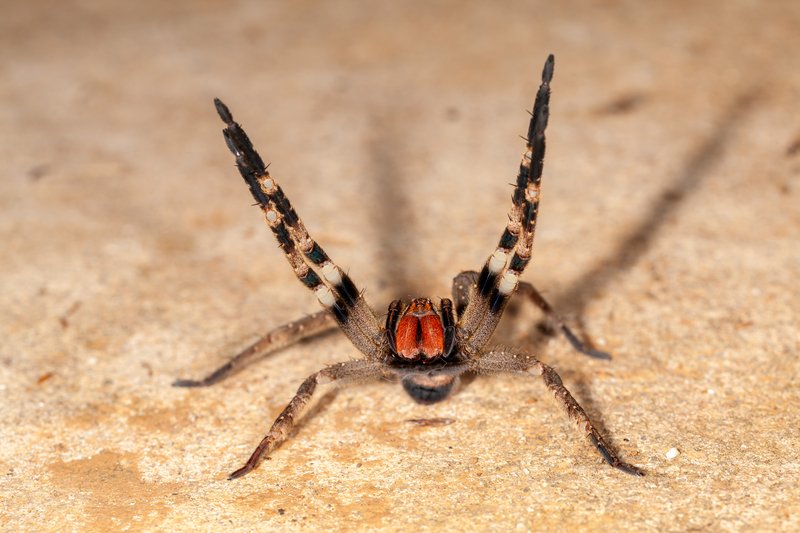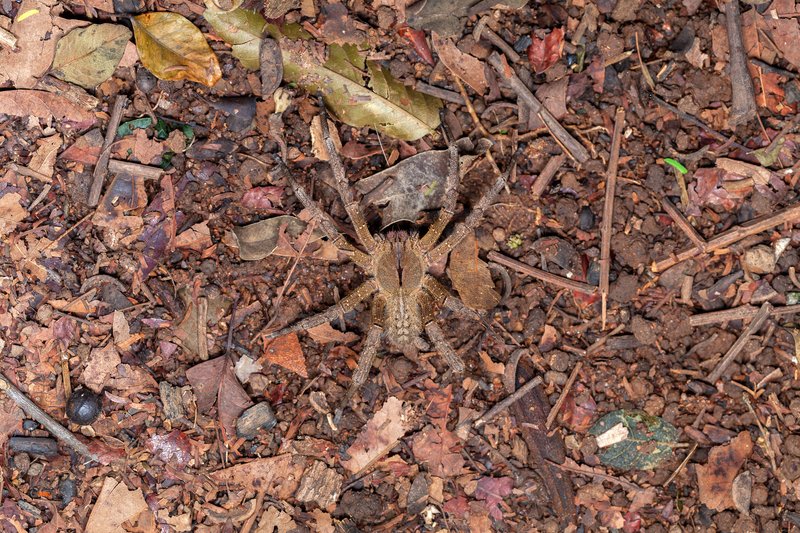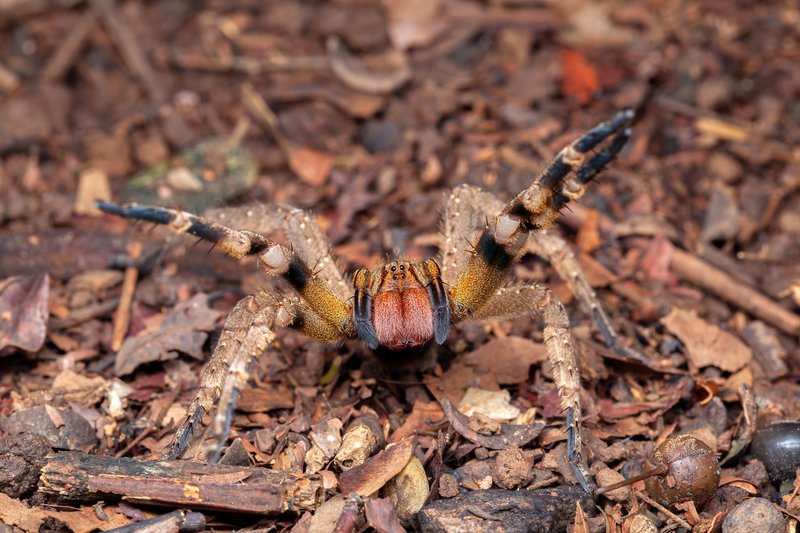You may have heard of the Brazilian Wandering Spider, and if not, you should definitely familiarize yourself with this 8-legged monster. You should especially do so if you plan on visiting the beautiful country.
This species of spider is not only massive but extremely dangerous. Therefore, when visiting Brazil’s beautiful country, you should familiarize yourself with the Brazilian Wandering Spider. Here are reasons why you should never keep one and all the information about them.
Why Are Brazilian Wandering Spiders Dangerous?
Brazilian Wandering Spiders are dangerous because they are not only aggressive, they are also one of the most poisonous arachnids in the world! In the Guinness Book Of World Records, this spider has ranked the “most venomous spider” in the world.
Their genus name “Phoneutria” can be taken as a warning to their deadly nature as it means “murderess” in Greek. They are active hunters, which adds to their aggression because they are natural predators.
While many venomous spiders are often small and can be missed, the Brazilian Wandering spider can grow up to half a foot (almost the size of a rodent!). This means that you pretty much can’t miss them if you come across them.
It is good to remember that they are not Tarantula, although they may have some similarities. They are actually not even in the same family. Tarantulas are harmless to humans, while these spiders can be quite harmful.
What Happens If A Brazilian Wandering Spider Bite You?
If at all possible, try to refrain from approaching a Brazilian Wandering Spider. They only bite when trying to protect themselves. If you leave them alone and do not provoke them, you can walk away unscathed.

But in case that you do get bit, here are a few things you can do:
- First, mark around the bite how far any rashes or redness has spread. (This will show medical professionals how fast symptoms are spreading).
- Get someone to drive you to the nearest emergency room because symptoms can cause you to lose control of muscle functioning.
- Try to keep calm by concentrating on your breathing. Increasing your heart rate can increase the spread and will only do more harm than good.
Even if you think the symptoms are mild, you should go to the emergency room immediately. The toxins produced by these spiders are deadly and can cause many symptoms.
Symptoms After You Have Been Bitten By A Brazilian Wandering Spider
The Brazilian Wandering Spider can offer a wide range of symptoms after you have been bitten. Here are some signs and symptoms you will want to look out for while seeking medical attention:
Initial Symptoms
- Sweating
- Goosebumps or hives
- Burning at site of bite
- Pain
Severe Symptoms
- Irregular heartbeat
- Racing heart rate
- Slow heart rate
- High or low blood pressure
- Abdominal cramping
- Hypothermia
- Vertigo
- Nausea
- Lightheadedness
- Signs and symptoms related to shock
It is important that if you are bitten by a spider that you think could be the Brazilian Wandering Spider, you should go to the emergency room immediately. In severe cases, the toxin can cause long-lasting damage and/or death.
Can You Keep A Brazilian Wandering Spider As A Pet?
Because they are aggressive and have a venomous bite, it is advised not to keep this species as a pet. This species of spider is not like Tarantulas. Although they do have venom, they are harmless to humans. Most injuries caused by this breed of arachnids are often because of the hairs and physical characteristics of the spider and not the poison they possess.
You may find that collectors or more experienced exotic pet owners have these spiders. However, even with this experience, these spiders should stay in the wild. They are meant to travel across spans of land and are not meant to live in captivity.
Where Is The Brazilian Wandering Spider Found In Brazil?
You won’t find these spiders up in the trees, waiting in their spider webs. Instead, they tend to live on the jungle floor, where they can hunt for food. This increases the chance that any humans going for a walk may come across them.

The Brazilian Wandering spider got its name from its nomadic lifestyle. It is constantly on the move and doesn’t like to set down roots. Although you can find them in Brazil, they are often found in many other places:
- Across South America
- Across Central America
- Parts of the United States
You can find them not only on forest floors but also in cities where there are many dark places for it to hide. These spiders are nocturnal, so they often are in hiding during the day and wandering around at night.
If you find yourself face to face with a wandering spider, it is best practice to leave it alone. Just ease some distance between you two to show it you aren’t a threat. They will not attack you unless you pose a threat to them.
How To Identify A Brazilian Wandering Spider
Surprisingly enough, the Brazilian Wandering Spider is considered the genius of the arachnid organism and has several species. But most of these species contain the same characteristics as each other and have similar behaviors.
You can look at the following to decide whether or not you have come across this type of spider:
- Physical characteristics
- Behavior
- Breeding habits
- Their bite
- By the signs they will attack
Brazilian Wandering Spider Physical Characteristics
Most species of the Brazilian Wandering Spider is a variation of brown, and all species will be hairy. Some may have black on them as well, sometimes in a spotted pattern. They tend to have a red jaw beneath, but you don’t want to look closely to see this feature.
These spiders are large in size compared to other spiders, with their legs reaching about 6 inches. Their bodies are often about 2 inches in length and sometimes have a black spot on their bellies.
Brazilian Wandering Spider Behavior
They travel on the ground and don’t ever make webs to catch their prey. Because of this, they are natural predators and hunters, adding to their aggressive demeanor. They will not attack humans if you leave them alone. However, if they do feel threatened, they will bite. Therefore, it is best to leave them alone.
They don’t stick around long, so don’t be afraid that they will make a nest or underground lair near you. This is unlikely behavior. They aren’t called the “wandering” spider for no reason. They love to place. The only reason they got their name was that they were first discovered in Brazil.
The Brazilian Wandering Spider Breeding Habits
The females will always be larger in size compared to the males. Males will approach the females with caution and provide their sperm. The female can store it in a separate compartment until she is ready to become pregnant.
Although many species are considered more dangerous at this time, their behavior stays pretty normal. They are hostile by nature, and during mating, they will remain the same. However, they do not mind being combative.
The Brazilian Wandering Spider Bite
The Brazilian Wandering Spider is known for its potent venom. This is because it is a complex concoction of toxins, proteins, and peptides. What this means is that it is that much more difficult for your body to fight the toxin.
The venom also increases the nitric oxide in your blood which causes increased blood flow. This is why it can increase your blood pressure and cause an irregular heartbeat. Both of these can lead to a heart attack or cardiac arrest.
The increased blood flow is also the reason for the effects of the venom to become severe in less than 30 minutes. It can also cause a painful erection in men after a single bite. This is why the Brazilian Wandering spider’s venom is incorporated into drugs for erectile dysfunction.
Although you will have severe symptoms from their bite, they do not inject all of their venoms. Their bite is meant to buy them time to get away from you because they have felt threatened by you. If they injected all their venom, they would be left vulnerable to other predators.
Signs The Brazilian Wandering Spider Is Going To Attack
If you are still wondering how to identify if you have come across a Brazilian Wandering Spider, watch closely to see if they are readying themselves for an attack. They will only attack you if they feel threatened.
When they are threatened, they will raise their front legs high and expose their red jaw. At this point, they aren’t in the best of moods, and you will find them to be more aggressive. If you see a spider in this stance, proceed with caution and try to put distance between you and the spider. They are quite aggressive at this point and will charge you.

How To Get Rid Of The Brazilian Wandering Spider
Whether you live in the country or the city, there is still the chance you can come across a Brazilian Wandering spider. This is due to their transient lifestyle of being on the move. They often stay in areas only during the day to rest, but sometimes you may find them in places you don’t want them.
Where To Inspect
They like to hide in the dark, damp places, so they will most likely be anywhere that provides such an environment. This means in clothing stored in a garage, boxes, firewood piles, or other places where there is a lot of clutter.
They have been nicknamed “banana spiders” because they have often been found within banana crates. They don’t actually eat bananas, so don’t expect them to be there because they’re hungry. Instead, they were taking a break.
Preventive Measures
Before one of these venomous spiders enters your home and you have to react, there are plenty of preventive measures you can take. You can do many of the following to deter these predators:
- Decluttering your home
- Organize your storage spaces
- Clean your house regularly
- Cutting off access to your home
- Get rid of their food source
Decluttering Your Home
These spiders love to hide in dark places. An easy way to deter them from coming into your home and give you more safety is to declutter the main areas you and your family live in. If you can, try to declutter the entire home.
You can do this by first getting rid of any items that you no longer need. Don’t leave any items on the ground or places where these spiders can hide under or in. Your closets, pantries, and garage should be decluttered so that nothing falls on you while trying to grab an extra blanket.
Organize Your Storage Spaces
Organize any storage spaces you have. This includes places like pantries, closets, attics, and garages. You don’t want to pull out an old box and have a Brazilian Wandering Spider jumping out at you.
Invest in sealable bins. Cardboard boxes aren’t always fully sealed and can become damp and moldy over time. It is best to store them in these locked and sealed boxes so that the spiders don’t have a place to hide in. It will also help with any cluttering and easier access to items you need to get to often.
Clean Your House Regularly
Make sure you are cleaning your house regularly. That doesn’t mean sticking your hands in corners and cracks. Instead, take a broom underneath your couch or move some of your furniture to make sure nothing is starting to make a home in your home.
Understandably, you can’t always have the cleanest home every day, but try to clean your home deep at least once a month to prevent any nests from forming. Thankfully, this breed of spider doesn’t stay long in one place, so if they don’t find a home immediately, they will move on to the next spot.
Cutting Off Access To Your Home
You can easily survey your home and see any areas where a large spider can crawl in. This means closing up any holes or leaks. You can also proof your doors and windows and make sure all the screens on your windows are not torn.
Fixing these access points may seem like little, but this can deter a spider of this size from entering your home. Remember that most of the time, they are only trying to find a home for the day, maybe even two, and they move on to their next home. They are nomadic.
Get Rid Of Their Food Source
Brazilian Wandering Spiders follow their food source. They will go where their food is so that they can survive. You can get rid of the food source, which causes the spider to explore other areas for their next meal. Their diet consists of the following:
- Crickets
- Other large insects
- Small lizards
- Small mice
Reactive Measures
If you have come across a spider in your home, there are many things you can do. The biggest thing is to stay clear of it. When it rears its front legs, it is ready to bite you to defend itself. If this is happening, get away from it as soon as possible. Here are two reactive measures if you find yourself in this situation: chemically treating your home or laying out glue traps.
Chemically Treat Your Home
You can chemically treat your home. There are many concoctions you can buy at the store and do it yourself. Remember to stay vigilant if you take this route and pay attention to your surroundings. A Brazilian Wandering Spider won’t seek you out, but it will attack if you get too close.
If you don’t want to mess with the spider, call an exterminator. They can spray your home, lawn, and any other areas that need it. It may cost more than buying a bug bomb at your local store, but their procedure will more likely chase it away.
Lay Out Glue Traps
You can find glue traps at your local general store. You lay these out, and when the spider walks across them, it gets stuck. You can use these for other insects and small rodents as well. It is a simple way of controlling whether there’s a Brazilian Wandering Spider in your house.
These are great to catch these spiders but can be a nuisance if you have pets within your home. Your pets can get caught when curiously looking at it. If you use these in a home with pets or children, it is best to put them in places where neither category can find them. Glue traps are painful to remove from skin and fur.
Outro
Brazilian Wandering Spiders are not only venomous but aggressive. You do not want to come across one and make it feel threatened. They will bite, and you will reap the consequences of that venom.
They are meant to stay in the wild and travel to distant places. They aren’t meant to stay in one spot. So as long as you leave them alone and don’t disturb them, you will find that you two can coexist with no issues whatsoever.
While you are here, I think we might interest you with these:
Capybara: All You Need to Know About the Chillest Animal on Earth – Capybaras are some of the most popular and dearest animals in Brazil, so if you are planning to come to the country, you better get into the Capybara craze!
9 Best Places to Swim with Dolphins in Brazil – Every heard of the Brazilian Pink Dolphin? While in Brazil, taking the opportunity to swim with these majestic creatures is a must, so here are the best places to do it!
Moving To Brazil With My Pet: How To Take Them – If you are moving to Brazil, we have all the info you will need in order to bring your best friend with you, so take a look!
Cover Photo: up-close shot of a Brazilian Wandering Spider – Credit: ID 195710680 © Viniciussouza06 | Dreamstime.com
